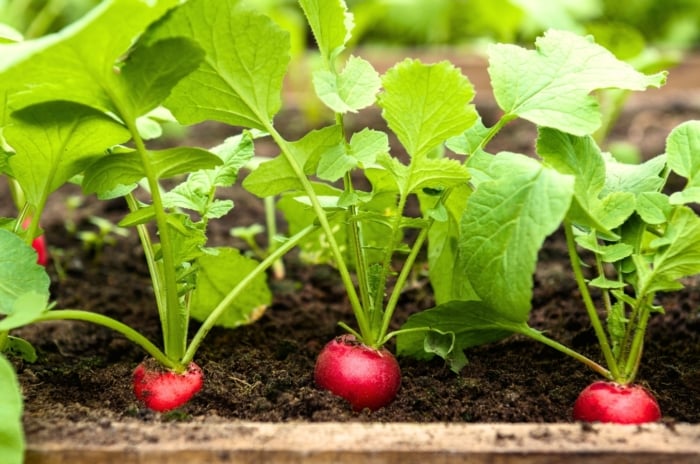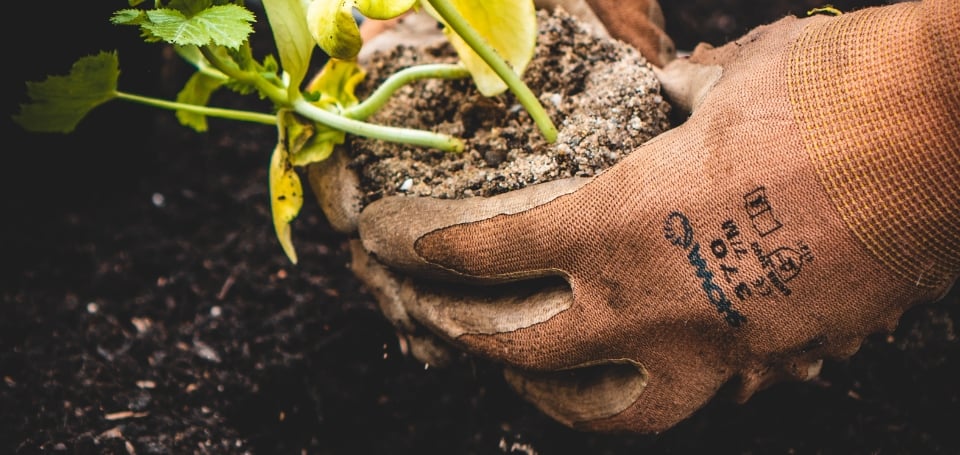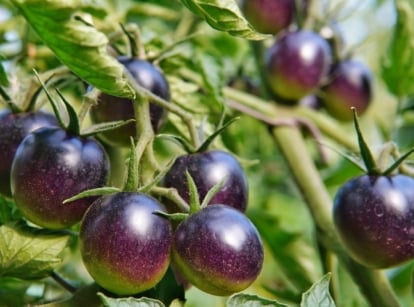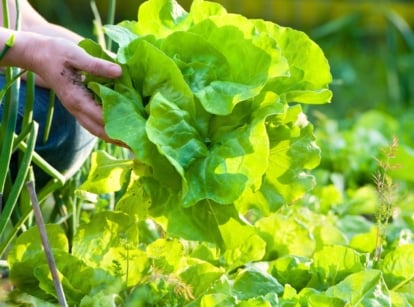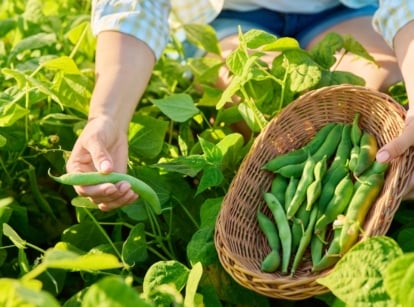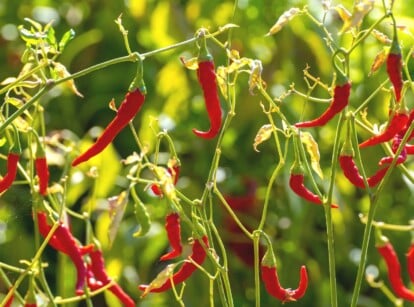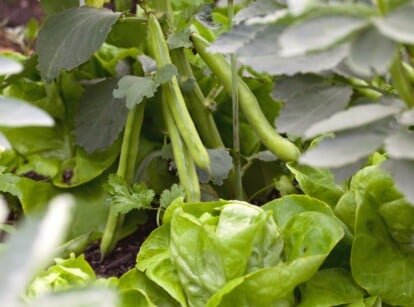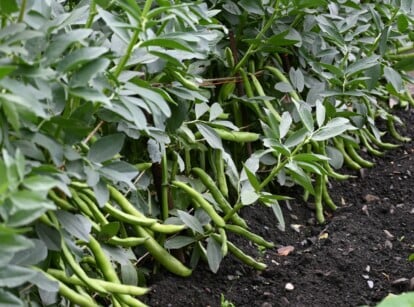How to Plant, Grow, and Care for ‘Red Noodle’ Beans
‘Red Noodle’ beans grow over a foot long and add a unique twist to green beans. Join farmer Briana Yablonski to learn how to plant and care for these interesting beans.

Contents
One of my favorite summer garden rituals is picking snap beans and cooking them the same day. However, my body hates bending over to scan the plants for their green beans. That’s one reason I love ‘Red Noodle’ beans.
This unique variety of cowpeas grows up trellises and arbors, eliminating the need to hunch over to harvest. And since the tender beans can grow over a foot long, you only have to pick a few to have enough for a meal!
These plants also thrive in intense summer heat and seem more resistant to common pests than other bean varieties. Not to mention, the long red beans are a real conversation starter. Keep reading to learn how to plant and care for ‘Red Noodle’ beans in your garden.
‘Red Noodle’ Bean Overview
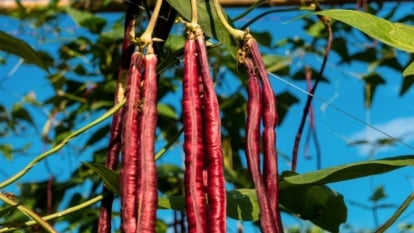
|
Plant Type
Annual
Family
Fabaceae
Genus
Vigna
Species
Unguiculata
|
Native Area
Southeast Asia
Exposure
Full sun
Height
4-8 feet
Watering Requirements
Moderate
|
Pests & Diseases
Mexican bean beetle, bean leaf beetle
Maintenance
Moderate
Soil Type
Well-draining
Hardiness Zone
5-13
|
What Are ‘Red Noodle’ Beans?

‘Red Noodle’ is a cultivar of yard-long beans with slender, burgundy pods that can grow over a foot long. Like most long types, they’re cowpeas that people have selected for their impressively long pods. Each elongated cluster contains multiple individual beans, but you can eat the entire tender pod.
Characteristics

‘Red Noodle’ beans are a type of climbing cowpea. The plants produce long, trailing stems that can grow over eight feet tall. The vines grow quickly and produce large leaves with three distinct leaflets. Light purple flowers appear about two months after planting.
Once these flowers are pollinated, they turn into slender pods. The pods are deep red in color and contain multiple beans. Each pod can grow over a foot long, but they typically stay around as wide as a pencil. If left on the plant, the pods eventually swell and transform from firm yet tender to soft and squishy.
The long, tender beans have a sweet and slightly nutty flavor that lends itself well to various dishes.
Native Area

The history of cowpeas is complicated and not fully known. However, historians believe that cowpeas were first cultivated in Africa as early as 2500 BCE. The plants were well adapted to the hot temperatures and dry soil present throughout parts of East and West Africa.
Eventually, cowpeas made their way to Asia, where they were further cultivated. Growers in the area selected plants with trailing vines and long pods, and the resulting plants are now known as yard long beans. The ‘Red Noodle’ bean likely emerged in China.
Planting

Although you can grow ‘Red Noodle’ beans by direct sowing or transplanting, planting the seeds directly in your garden is the easiest and most commonly used method. Since this crop requires warm temperatures to germinate and thrive, you should wait until the soil warms to at least 65°F (18°C) before sowing. In many areas, planting a month after your last spring frost is ideal.
Since the vining plants require a vertical support to grow, think about how you’ll trellis them before planting. You can plant the seeds at the base of a horizontal pole or piece of bamboo, utilize a piece of fencing or cattle panel for support, or grow them along an arbor.
If you’re planting them in a row, space each bean three to four inches apart. If you’re using a pole for support, plant a few seeds at the base of each support.
Plant the seeds one inch under the soil and water well. They should sprout within a week, but expect slower germination when the soil is cool.
How to Grow
‘Red Noodle’ beans are easy to grow in warm climates as long as you provide them with a proper trellis. They experience less pest and disease pressure than bean varieties of the Phaseolus vulgaris species.
Light

‘Red Noodle’ beans grow best in full sun, so plant them in a bright, unobstructed area. Provide at least eight hours of direct light each day.
Water

Like most cowpeas, ‘Red Noodle’ beans can tolerate drought once they’re established. However, the seedlings prefer the soil to remain moderately moist during their first month of growth. Irrigating the young plants a few times a week is generally sufficient.
Once the plants are mature, they may still require irrigation during prolonged dry spells. If you have hot and dry conditions, plan to water them about once a week. Deep, infrequent waterings are better than regular, shallow irrigation.
Drip irrigation is preferred to overhead since it keeps plant leaves dry and limits water loss via evaporation. If you don’t want to set up a drip irrigation system, you can water the base of the plants with a hose or watering can.
Soil

‘Red Noodle’ beans aren’t too picky about the soil and can even grow well in poor and rocky ground. However, they prefer soil that drains well. If you’re working with compacted soil that leads to standing water, aerate the ground with a digging fork or shovel before planting.
Temperature and Humidity

These plants thrive in hot temperatures, so they grow best in zones seven and above. While many plants suffer when temperatures rise above 90°F (32°C), these legumes don’t mind the hot weather. You can grow the plants if you live in zone 5 and 6, but expect smaller harvests than growers in warmer areas.
These plants are not frost-tolerant and will be unhappy when temperatures are below 60°F (16°C). Therefore, you should wait until the soil and air warm before planting them outside. Since they take around three months to produce their first bean, get them in the ground early enough that you’ll be able to harvest before cool fall temperatures arrive.
If you live in an area with a short growing zone, you can heat the soil by covering it with black plastic. This will also help kill any weeds that lie waiting underground. After you plant the bean seeds, cover the area with row cover to warm the soil and protect the tender seedlings from the cold.
‘Red Noodle’ plants aren’t bothered by high humidity, but they don’t require it. They can grow well in the humid Southeast and the arid West Coast.
Fertilizing

Since ‘Red Noodle’ is a legume, it forms symbiotic relationships with nitrogen-fixing bacteria called Rhizobia. These bacteria live on nodules on the plants’ roots and work to convert atmospheric nitrogen into a plant-available form. The plants provide the bacteria with necessary carbohydrates, and the rhizobia provide the legumes with nitrogen.
In soil with healthy levels of Rhizobia bacteria, you don’t need to apply nitrogen fertilizer before planting. Inoculating the seeds with the proper type of Rhizobia before planting will help ensure the beans can form symbiotic associations with the bacteria.
Although ‘Red Noodles’ don’t need nitrogen fertilizer to remain healthy, they may benefit from the application of other nutrients. A soil test is always the best way to determine which nutrients your soil is lacking. You can also supply a low-nitrogen fertilizer if you think your soil is lacking nutrients, but you don’t want to conduct a soil test.
Maintenance

Trellising is the major maintenance step required to keep these plants healthy. While you can let the trailing stems run across the ground, they will quickly cover your garden, and harvesting will be a pain. A better option is to provide a trellis that the plants can grow up.
If you’re growing your beans in rows, you can secure a cattle fence panel of a piece of Hortonova trellis between two t-posts. The stems will wind up the trellis and grasp on for support. You may need to direct the stems to the trellis when they are young, but they will grow fine on their own once they’re attached.
If you’re growing on a smaller scale, you can find many different types of trellises that work in raised beds or small gardens. You can also plant your pole beans beside an arbor or use single stakes of bamboo to support the plants.
Harvesting and Storage

You can expect to begin harvesting mature pods about three months after you sow the seeds. Aim to harvest when they are between 12-18” long, the diameter of a pencil, and firm. They should easily snap if you bend them.
If you let them get too mature, the pod will become soft. While the beans are still edible at this stage, they don’t taste as good as the younger pods. Smaller ones are also edible, but they won’t hold up as well in storage.
Once you harvest, place them in the refrigerator. They should remain fresh for about a week.
Propagation

The best way to propagate ‘Red Noodle’ beans is to grow them from seed. If you want to collect and save the seed, let a few pods fully mature on the plants. They will continue to grow, and the pods will eventually turn brown and dry.
Pick the mature pods and set them in a dry area with excellent airflow. Once the pods are completely dry, crack them open to reveal the mature bean seeds. Store them in an airtight container in a cool, dark location.
Common Problems
‘Red Noodle’ beans are relatively easy to grow and face few serious problems. Keeping an eye out for the following will help you keep your plants healthy.
Mexican Bean Beetles

These small beetles are one of the main pests of ‘Red Noodle’ beans. Although they don’t attack these plants as much as other bean varieties, they can still become a problem as they feed on the foliage, flowers, and bean pods.
Both the adults and larvae feed on the plants. The adults are yellow beetles with 16 black spots on their backs. They are the size and shape of ladybugs.
In the summer, the beetles lay clusters of elongated, bright yellow eggs on the backs of bean leaves. These eggs hatch into yellow larvae covered with fuzz-like spines. The larvae complete four stages, growing larger each time they molt.
Plants can withstand some damage without any decrease in yield, but harvests will begin to decline once 20% of the foliage is affected. Therefore, you should consider treating the pests if they become out of control.
Start by checking the undersides of the leaves for eggs and larvae and squish them with your hands. You can also spray the pests with neem oil or pyrethrum.
Bean Leaf Beetle

Bean leaf beetles are common bean pests that range in color from red to brown to yellow. They are about a quarter of an inch long and have black patches on the wing covers. Although they are typically more problematic on green beans, they can also feed on cowpea varieties like ‘Red Noodle.’
The adults feed on plant leaves and pods, preferring tender, young growth. The worm-like larvae live underground and feed on bean roots, but they rarely cause notable damage.
A small number of these beetles won’t cause serious damage to your plants, so picking off adults may be the only action you need. However, you can also spray them off with water if a large population exists.
Frequently Asked Questions
What do ‘Red Noodle’ beans taste like?
‘Red Noodle’ beans have a sweet and slightly nutty flavor. They taste a little less herbaceous than green beans and have notes of mushrooms and seeds.
How do you cook ‘Red Noodle’ beans?
You can enjoy these yard long beans cooked. Try adding them to a stir fry, cooking them in soup, or tossing them into curries.
Are ‘Red Noodle’ beans good producers?
Yes! These plants grow well in most warm climates and produce lots of long beans.

